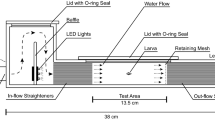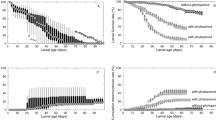Abstract
Most marine fish species disperse during a planktonic larval stage where individuals exhibit variation in pelagic duration, growth rate and settlement size. Extreme predation risk is predicted to select for rapid growth rates and decreased pelagic duration as a strategy for increasing survival to settlement. How larval traits affect post-metamorphic performance, however, has been a contentious topic over the past 50 yrs. Some studies suggest that larval traits have carry-over effects to later life stages, where larval traits can be positively or negatively correlated with post-metamorphic performance. For example, individuals with rapid larval growth rates may settle at larger sizes and have faster post-metamorphic locomotion than slow-growing individuals. Alternatively, trade-offs between life stages might exist, where rapid larval growth rate may be negatively correlated with post-metamorphic locomotion, potentially due to energetic resource allocation trade-offs. In addition, other studies suggest that larval traits are decoupled from later life stages to allow for a transition in morphology and habitat. We tested how Bathygobius cocosensis hatch size, larval growth rates, settlement size and pelagic duration correlated with post-metamorphic thermal performance of burst swimming speed, routine metabolic rate and critical thermal maximum. We found that larval growth rate was negatively correlated with juvenile routine metabolic rate and burst swimming speed across a range of test temperatures. That is, fast-growing larvae had slower burst swimming speeds and lower routine metabolic rates across temperature as juveniles compared to slower-growing larvae. We also found that hatch size and pelagic larval duration were not correlated with post-metamorphic performance. Thus, we provide evidence both for larval traits having carry-over effects on later life stages and also for larval traits being decoupled with thermal performance post-metamorphosis. This is the first study to show that rapid larval growth rate is costly for post-metamorphic thermal performance.






Similar content being viewed by others
References
Alvarez D, Nicieza AG (2002) Effects of induced variation in anuran larval development on postmetamorphic energy reserves and locomotion. Oecologia 131:186–195
Arendt JD (2003) Reduced burst speed is a cost of rapid growth in anuran tadpoles: problems of autocorrelation and inferences about growth rates. Funct Ecol 17:328–334
Arendt J, Wilson DS, Stark E (2001) Scale strength as a cost of rapid growth in sunfish. Oikos 93:95–100
Arnold SJ, Wassersug RJ (1978) Differential predation on metamorphic anurans by garter snakes (Thamnophis): social behavior as a possible defense. Ecology 59:1014–1022
Arnott SA, Chiba S, Conover DO (2006) Evolution of intrinsic growth rate: metabolic costs drive trade-offs between growth and swimming performance in Menidia menidia. Evolution 60:1269–1278
Banks B, Beebee TJC (1988) Reproductive success of natterjack toads Bufo calamita in two contrasting habitats. J Anim Ecol 57:475–492
Bates D, Mächler M, Bolker B, Walker S (2015) Fitting linear mixed-effects models using lme4. J Stat Softw 67:48–99
Billerbeck JM, Lankford TE, Conover DO (2001) Evolution of intrinsic growth and energy acquisition rates. I. Trade-offs with swimming performance in Menidia menidia. Evolution 55:1863–1872
Brett JR (1964) The respiratory metabolism and swimming performance of young sockeye salmon. J Fish Res Board Can 21:1183–1226
Careau V, Thomas D, Humphries MM, Reale D (2008) Energy metabolism and animal personality. Oikos 117:641–653
Cowen RK, Sponaugle S (2009) Larval dispersal and marine population connectivity. Ann Rev Mar Sci 1:443–466
Crean AJ, Monro K, Marshall DJ (2011) Fitness consequences of larval traits persist across the metamorphic boundary. Evolution 65:3079–3089
da Silva CRB, Riginos C, Wilson RS (2019) An intertidal fish shows thermal acclimation despite living in a rapidly fluctuating environment. J Comp Physiol B. https://doi.org/10.1007/s00360-019-01212-0
Domenici P, Blake R (1997) The kinematics and performance of fish fast-start swimming. The Journal of Experimental Biology 200:1165–1178
Ebenman B (1992) Evolution in organisms that change their niches during the life-cycle. Am Nat 139:990–1021
Ficetola GF, De Bernardi F (2006) Trade-off between larval development rate and post-metamorphic traits in the frog Rana latastei. Evol Ecol 20:143–158
Fischer K, Zeilstra I, Hetz SK, Fiedler K (2004) Physiological costs of growing fast: does accelerated growth reduce pay-off in adult fitness? Evol Ecol 18:343–353
Gimenez L (2010) Relationships between habitat conditions, larval traits, and juvenile performance in a marine invertebrate. Ecology 91:1401–1413
Griffiths SP (2003) Rockpool ichthyofaunas of temperate Australia: species composition, residency and biogeographic patterns. Estuar Coast Shelf S 58:173–186
Grorud-Colvert K, Sponaugle S (2011) Variability in water temperature affects trait-mediated survival of a newly settled coral reef fish. Oecologia 165:675–686
Hickey GL, Mokhles MM, Chambers DJ, Kolamunnage-Dona R (2018) Statistical primer: performing repeated measures analysis. Interactive CardioVasculat and Thoracic Surgery 26:539–544
Husak JF (2006a) Does speed help you survive? A test with Collared Lizards of different ages. Funct Ecol 20:174–179
Husak JF (2006b) Does survival depend on how fast you can run or how fast you do run? Funct Ecol 20:1080–1086
Johansson F, Lederer B, Lind MI (2010) Trait performance correlations across life stages under environmental stress conditions in the common frog, Rana temporaria. Plos One 5:e11680
Lande R (1988) Genetics and demography in biological conservation. Science 241:1455–1460
Lutterschmidt WI, Hutchison VH (1997) The critical thermal maximum: history and critique. Can J Zoo 75:1561–1574
Malard LA, McGuigan K, Riginos C (2016) Site fidelity, size, and morphology may differ by tidal position for an intertidal fish, Bathygobius cocosensis (Perciformes-Gobiidae), in Eastern Australia. PeerJ 4:e2263
Mangel M, Stamps J (2001) Trade-offs between growth and mortality and the maintenance of individual variation in growth. Evol Ecol Res 3:583–593
Marshall DJ, Keough MJ (2004) Variable effects of larval size on post-metamorphic performance in the field. Mar Ecol Prog Ser 279:73–80
Marshall DJ, Bolton TF, Keough MJ (2003) Offspring size affects the post-metamorphic performance of a colonial marine invertebrate. Ecology 84:3131–3137
Marshall DJ, Cook CN, Emlet RB (2006) Offspring size effects mediate competitive interactions in a colonial marine invertebrate. Ecology 87:214–225
McCarthy ID (2000) Temporal repeatability of relative standard metabolic rate in juvenile Atlantic salmon and its relation to life history variation. J Fish Biol 57:224–238
Meekan MG, Fortier L (1996) Selection for fast growth during the larval life of Atlantic cod Gadus morhua on the Scotian Shelf. Mar Ecol Prog Ser 137:25–37
Messmer V, Pratchett MS, Hoey AS, Tobin AJ, Coker DJ, Cooke SJ, Clark TD (2017) Global warming may disproportionately affect larger adults in a predatory coral reef fish. Global Change Biology 23:2230–2240
Moginie BF, Shima JS (2018) Hatch date and growth rate drives reproductive success in nest-guarding males of a temperate reef fish. Mar Ecol Prog Ser 592:197–206
Moran NA (1994) Adaptation and constraint in the complex life-cycles of animals. Annu Rev Ecol Syst 25:573–600
Newman RA (1988) Adaptive plasticity in development of Scaphiopus couchii tadpoles in desert ponds. Evolution 42:774–783
Ospina AF, Mora C (2004) Effect of body size on reef fish tolerance to extreme low and high temperatures. Environmental Biology of Fishes 70:339–343
Paijmans KC, Wong MY (2017) Linking animal contests and community structure using rockpool fishes as a model system. Funct Ecol 31:1612–1623
Parichy DM (1998) Experimental analysis of character coupling across a complex life cycle: Pigment pattern metamorphosis in the tiger salamander, Ambystoma tigrinum tigrinum. J Morphol 237:53–67
Pechenik JA (2006) Larval experience and latent effects - metamorphosis is not a new beginning. Integrative and Comparative Biology 46:323–333
Pechenik JA, Wendt DE, Jarrett JN (1998) Metamorphosis is not a new beginning. Bioscience 48:901–910
Pechenik JA, Hilbish TJ, Eyster LS, Marshall D (1996) Relationship between larval and juvenile growth rates in two marine gastropods, Crepidula plana and C. fornicata. Mar Biol 125:119–127
R Core Team (2013) R: A language and environment for statistical computing. R foundation for statistical computing
Recsetar MS, Zeigler MP, Ward DL, Bonar SA, Caldwell CA (2012) Relationship between fish size and upper thermal tolerance. T Am Fish Soc 141:1433–1438
Relyea RA (2001) The lasting effects of adaptive plasticity: Predator-induced tadpoles become long-legged frogs. Ecology 82:1947–1955
Schluter D (1995) Adaptive radiation in sticklebacks: trade-offs in feeding performance and growth. Ecology 76:82–90
Schulte PM, Healy TM, Fangue NA (2011) Thermal performance curves, phenotypic plasticity, and the time scales of temperature exposure. Integrative and Comparative Biology 51:691–702
Seebacher F, Beaman J, Little AG (2014) Regulation of thermal acclimation varies between generations of the short-lived mosquitofish that developed in different environmental conditions. Func Ecol 28:137–148
Shima JS, Swearer SE (2009) Larval quality is shaped by matrix effects: implications for connectivity in a marine metapopulation. Ecology 90:1255–1267
Shima JS, Swearer SE (2010) The legacy of dispersal: larval experience shapes persistence later in the life of a reef fish. J Anim Ecol 79:1308–1314
Sponaugle S, Cowen RK (1997) Early life history traits and recruitment patterns of Caribbean wrasses (Labridae). Ecological Monographs 67:177–202
Stevens ED, Sutterlin A, Cook T (1998) Respiratory metabolism and swimming performance in growth hormone transgenic Atlantic salmon. Can J Fish Aquat Sci 55:2028–2035
Strathmann RR (1985) Feeding and nonfeeding larval development and life-history evolution in marine invertebrates. Annu Rev Ecol Syst 16:339–361
Thia JA, Riginos C, Liggins L, Figueira WF, McGuigan K (2018) Larval traits show temporally consistent constraints, but are decoupled from post-settlement juvenile growth, in an intertidal fish. J Anim Ecol 87:1353–1363
Trakhtenbrot A, Nathan R, Perry G, Richardson DM (2005) The importance of long-distance dispersal in biodiversity conservation. Diversity and Distributions 11:173–181
Travis J, Keen WH, Juilianna J (1985) The role of relative body size in a predator-prey relationship between dragonfly naiads and larval anurans. Oikos 45:59–65
Victor BC (1984) Coral-reef fish larvae: patch size estimation and mixing in the plankton. Limnol Oceanogr 29:1116–1119
Vigiliola L, Meekan MG (2002) Size at hatching and planktonic growth determines post-settlement survivorship of a coral reef fish. Oecologia 131:89–93
Walker JA, Ghalambor CK, Griset OL, McKenney D, Reznick DN (2005) Do faster starts increase the probability of evading predators? Funct Ecol 19:808–815
Wellington GM, Victor BC (1985) El-nino mass coral mortality: a test of resource limitation in a coral-reef damselfish population. Oecologia 68:15–19
Wellington GM, Victor BC (1992) Regional differences in duration of the planktonic larval stage of reef fishes in the Eastern Pacific-Ocean. Mar Biol 113:491–498
White CR, Kearney MR (2014) Metabolic scaling in animals: methods, empirical results and theoretical explanations. Compr Physiol 4:231–256
Wichham H (2016) ggplot2: Elegant graphics for data analysis. Springer-Verlag, New York
Wilbur HM (1980) Complex life-cycles. Annu Rev Ecol Syst 11:67–93
Wilson DT, Meekan MG (2002) Growth-related advantages for survival to the point of replenishment in the coral reef fish Stegastes partitus (Pomacentridae). Mar Ecol Prog Ser 231:247–260
Acknowledgements
We would like to thank the UQ Heron Island Research Station Student Scholarship and The Herman Slade Foundation (HSF 13/14 to Riginos) for funding. We also thank Julian Beaman, Iva Popovic, Joshua Thia and Gwendolyn David for help in the field and editing previous versions. Thank you Nuria Raventos from the Advanced Research Centre of Blanes for extracting larval trait data from fish otoliths. Collection of B. cocosensis was approved by the University of Queensland limited impact permit for Great Barrier Reef Marine Park Authority (accreditation number: UQ006/2015). Animal ethics was approved by The University of Queensland Animal Ethics Unit (permit number: QS2015/MAN340).
Author information
Authors and Affiliations
Contributions
da Silva, Riginos and Wilson conceived conceptual ideas and designed experimental methodology. da Silva collected and analysed the data. da Silva lead the writing of the manuscript, and Riginos and Wilson contributed critically to the drafts. All authors gave the final approval for publication.
Corresponding author
Ethics declarations
Conflict of interest
On behalf of all authors, the corresponding author states that there is no conflict of interest.
Additional information
Topic Editor Morgan S. Pratchett
Publisher's Note
Springer Nature remains neutral with regard to jurisdictional claims in published maps and institutional affiliations.
Rights and permissions
About this article
Cite this article
da Silva, C.R.B., Wilson, R.S. & Riginos, C. Rapid larval growth is costly for post-metamorphic thermal performance in a Great Barrier Reef fish. Coral Reefs 38, 895–907 (2019). https://doi.org/10.1007/s00338-019-01815-7
Received:
Accepted:
Published:
Issue Date:
DOI: https://doi.org/10.1007/s00338-019-01815-7




